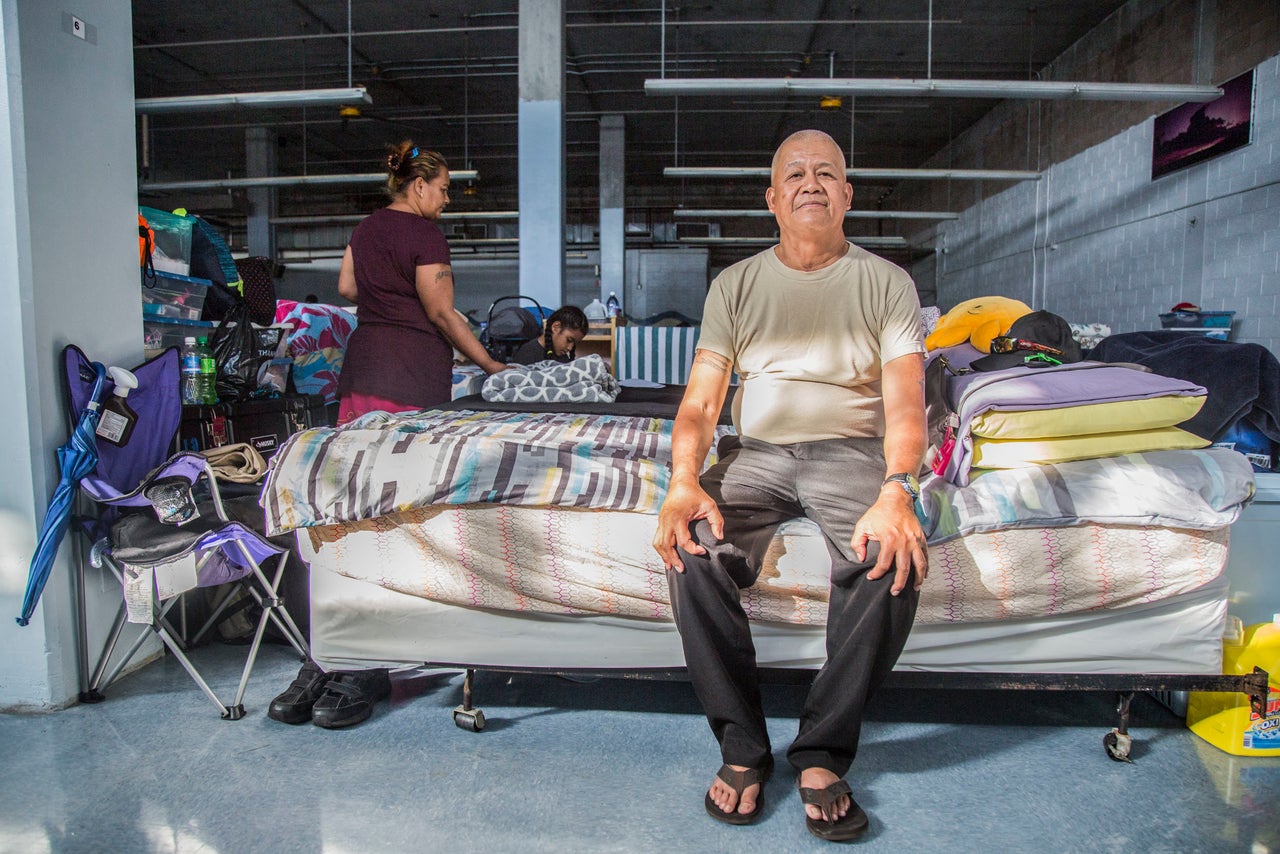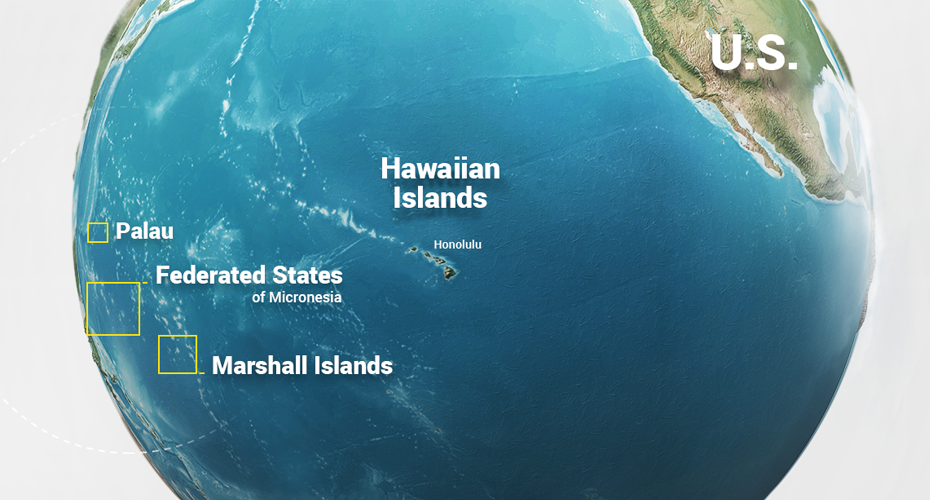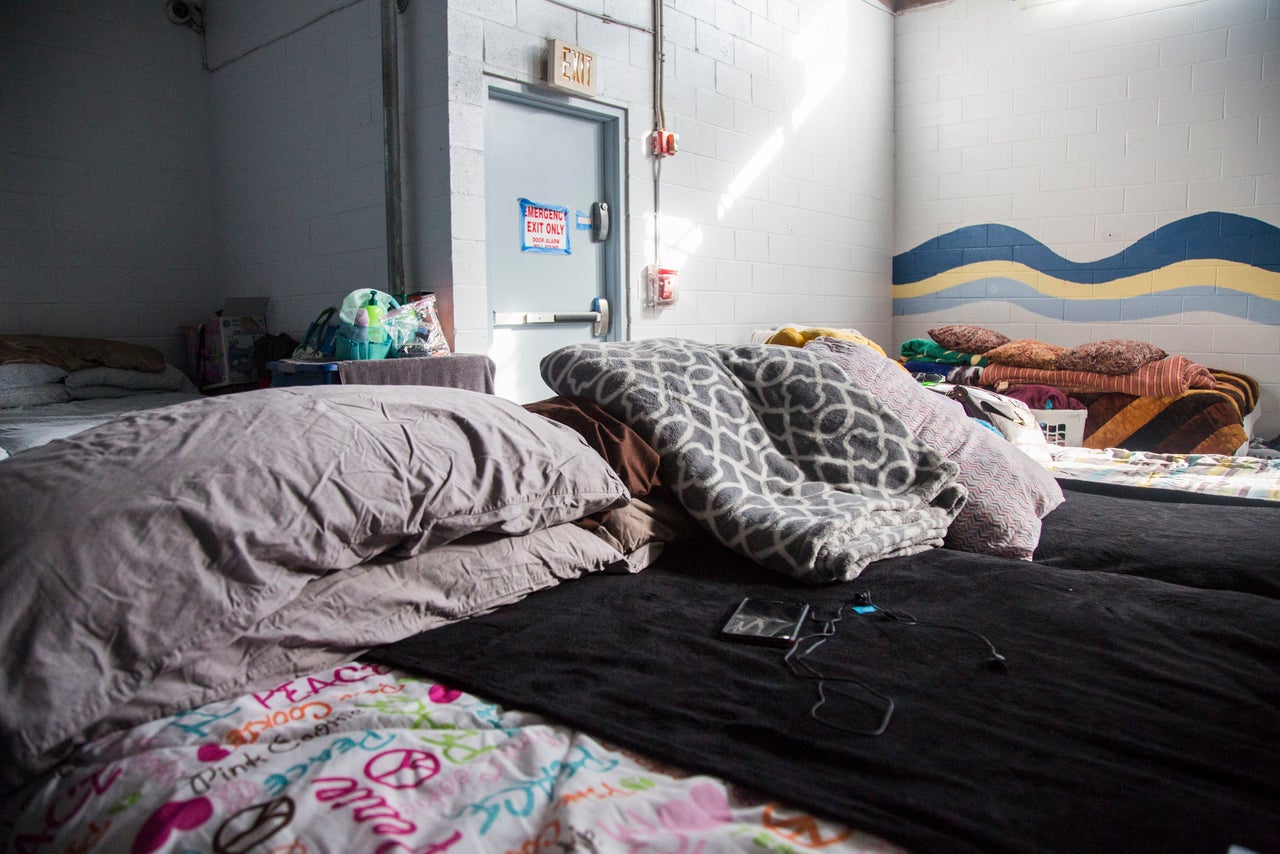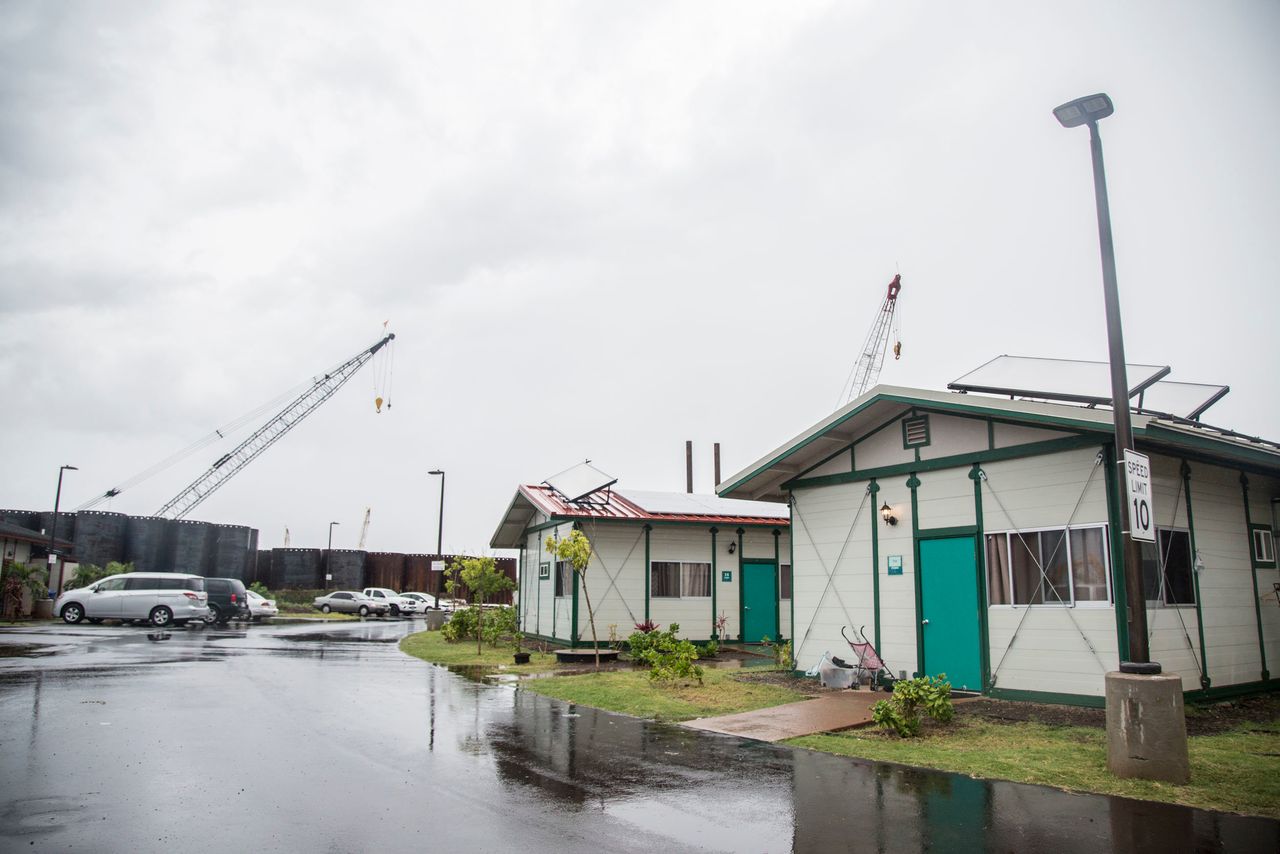HONOLULU ― When Jesse Biluk moved his family to Hawaii, he didn’t think they’d end up in a homeless shelter.
For several months, the 56-year-old and his wife, along with their younger daughter, slept in a giant cinderblock room with other struggling families. They stored their belongings in trunks and plastic boxes stacked near their beds. From the roof of the shelter, they could glimpse the ocean between clusters of gleaming high-rise hotels that line the nearby surfing beach
Biluk came to Honolulu last year from the Federated States of Micronesia (FSM), a remote country of tiny islands in the western Pacific around 3,500 miles away. He wanted his wife to have better access to treatment for her diabetes, and he hoped his 8-year-old could get a quality education.
A former policeman, Biluk found work as a security guard at a Honolulu Walmart and used his modest salary to lease a cheap apartment. But a series of medical emergencies and a rent hike meant he ended up with a choice: go hungry or move into a homeless shelter. Biluk chose the latter, and eight months down the line, with nothing more permanent on the horizon, he is moving his family again. This time to Alaska.
“I’m trying to survive,” Biluk told HuffPost. He didn’t expect life in America to be like this.

Biluk’s story of struggle and dislocation is not uncommon among the growing number of people from the Pacific region of Micronesia who have migrated to Hawaii over the past two decades. They come for better opportunities and, increasingly, to escape the encroaching impacts of climate change on their low-lying island nations. But they arrive to a state in the grip of one of the worst homelessness crises in the nation and to a society that doesn’t always accept them.
While their situation is a particular one, the challenges these migrants face trying to make a new home gives a glimpse into the bigger global problems as migration increases. By the end of the century, more than 13 million people in the U.S. alone could be forced to migrate because of sea level rises.
Migrants like Biluk can live and work in the U.S. without visas, thanks to a special arrangement with the U.S. government called the Compacts of Free Association (COFA). Three countries in the Micronesia region have such treaties: FSM, the Marshall Islands and Palau. They also get financial support in exchange for giving the U.S. military control over large parts of the Pacific.
America’s hold over these island nations tracks back decades. In the 1940s and 1950s, the U.S. conducted nuclear tests in the Marshall Islands, displacing entire communities and spreading fallout across the country.
Since COFA came into effect, the U.S. has given more than $6.75 billion in economic aid and other assistance to the nations. But the Micronesian economies remain largely underdeveloped — with limited health care and poor schools — pushing many people like Biluk to move to the U.S.
One of every three citizens from both the Marshall Islands and the FSM lives in America, as well as one in six citizens from Palau. In the U.S., they must pay taxes and can volunteer for the military, though they can’t vote or qualify for federal benefits like Medicaid.
While some of these migrants head to the mainland U.S., the most common destinations are Guam and Hawaii, with their familiar landscapes and relative proximity to Micronesia. They were respectively home to about 17,200 and 14,700 people from COFA nations in 2013. A new count is due this spring and some advocates estimate that the number of COFA migrants in Hawaii could now reach 18,000.
These figures look likely to keep rising as a ripple effect of climate change. Maxine Burkett, a University of Hawaii professor who studies climate and migration, says that the indirect consequences of a warming planet – such as reduced crop yields and access to freshwater – may compound existing economic problems pushing people to leave the Marshall Islands. Scientists and activists worry that low-lying areas of FSM and Palau could face a similar fate.
The fear is that “there will be a slow bleed, and you will essentially watch the beginning of a failing state because you’re losing your tax base,” Burkett said of the Marshall Islands. “Oftentimes, migrating can be a luxury … and you end up having people who would have been critical to [climate] resistance efforts move to the States because they can.”

Shanty Sigrah Asher, who came to Honolulu from the FSM state of Kosrae, said she and her husband sometimes struggle to afford their $1,800-a-month two-bedroom despite their reasonable salaries. The situation can be even worse for new arrivals who lack a formal education or English-language skills. They often find work in the generally lower-paying food and service industries, sending relatives back home what little money is left over from their paychecks.
“I don’t know how the other families do it,” said Asher, who works at the nonprofit Pacific Resources for Education and Learning. “Most of them don’t have cars, so they have to stay closer to where they work” in the city center, where rents tend to be higher.
Housing costs in Hawaii can be astronomical. The real estate firm Zillow pegs the median home value in Honolulu, Hawaii’s capital and population center, at around $677,000. A January report by Apartment List put the median rent for a two-bedroom apartment at $2,040 — more than 70 percent higher than the national average.
This city is also an international tourist destination, where foreign investors and vacation rentals have helped propel prices upward, housing activists say. With strict building regulations and high construction costs, the number of affordable units has been unable to keep up with demand.
Many incoming COFA migrants don’t have significant savings, let alone credit scores, making it even more difficult for them to get home loans or secure rental apartments.
Some COFA migrants, whose culture revolves around large, extended families, respond by doubling- or tripling-up in single apartments. “Micronesians want housing ASAP because, culturally, home is where the family is,” said Josie Howard, head of We Are Oceania, an organization that aims to ease Micronesians’ transition to Hawaii. But she added that some “people will get into housing and get kicked out fast because they don’t understand the [occupancy] rules.”
Soon after Biluk came to Hawaii, from Chuuk, his home island in the FSM, he scored a one-bedroom apartment where he moved with his wife and daughter. At $950 a month, it was a solid find in pricey Honolulu. But then two of his in-laws also moved in. Biluk said his landlord noticed the additional tenants and laid down an ultimatum: Pay $1,300 each month or leave.
Biluk had received a raise at his security job to $14 an hour and worked overtime on weekends. But the family’s medical bills were piling up. Biluk’s wife visited the emergency room twice after arriving from Chuuk, and his employer’s barebones insurance plan didn’t cover her. Biluk, who has gout, said there were times when money was so tight he’d forgo the out-of-pocket expense for his own medication.
They simply could not afford a dramatic rent increase. “If we [stay], we won’t be able to eat,” Biluk recalled telling his wife. He moved his wife and daughter into a shelter run by the Institute for Human Services, where they paid $130 a month for a place to sleep, meals and a semblance of stability.

While native Hawaiians comprise the largest share of the state’s homeless population, people from the Micronesia region experience homelessness at disproportionately high rates. At just over 1 percent of the state’s population, migrants from Micronesian countries comprised about 11 percent of the more than 15,000 people who used homeless services in the state in 2017.
Washington provided Hawaii with $12.8 million in 2018 to offset the costs of education, healthcare and other initiatives for COFA migrants. But it’s a pittance compared to the public expenses that the state says it spends on the migrants, with Hawaii reporting an average of more than $100 million annually between 2003 and 2014.
Homeless service organizations have at times helped pick up the slack. While nonprofits’ clienteles vary by location, representatives for three shelters visited by HuffPost in November said COFA migrants can make up between 20 and 50 percent of their clients at any given time.
Politicians have tried to fight for more assistance. Rep. Tulsi Gabbard (D-Hawaii) introduced legislation a year ago to increase federal support for such social services, and former Rep. Colleen Hanabusa (D-Hawaii) pledged to sue Washington for funds during a failed gubernatorial campaign last year. But mainland politicians don’t seem to be listening.
Meanwhile, Micronesian migrants in Hawaii face prejudice. Children are sometimes bullied in schools and migrants often deal with hate over social media. Stereotypes about Micronesians have even crept into the state’s ongoing debate over how to reduce homelessness.
The urgent need to address homelessness in Hawaii has culminated in a new strategy called “Housing First,” which emphasizes finding people homes as quickly as possible and then surrounding them with services.
The aim is to rapidly return the homeless to stable living situations, said Scott Morishige, the Hawaii State Homeless coordinator. “People move through the system faster,” he said, adding that the strategy targets families with children.
But it’s not always fast enough. At the Institute for Human Services, one of the largest Hawaiian organizations carrying out this strategic shift, Biluk was working with a case manager in the hope of landing one of Honolulu’s highly sought-after affordable units. After about eight months in the shelter — more than double the average stay — his family decided in February to give up their search and move to Anchorage, Alaska, where Biluk’s brother and sister live.
“We’ve been waiting and waiting, but there’s been no progress,” Biluk said, adding that he paid the airfare with money he’d been saving for an apartment. “Most of the families who came in after us already left.” It’s not uncommon for COFA migrants struggling to find affordable housing in Hawaii to leave for cheaper locations on the U.S. mainland.

There is some positive news. The state’s past two point-in-time counts — single-day snapshots of the homeless population — have seen declines in overall homelessness. The state’s total homeless population has dropped by around 18 percent over the past two surveys, with even greater declines among family homelessness.
Though the combined number of Micronesian and Marshallese people who use homeless services tends to fluctuate slightly from year to year, it’s trended downward since 2015, University of Hawaii studies suggest. These figures look promising, but they don’t provide a complete picture of homelessness ― just the number of people who sought out shelters or were connected with rehousing programs. Homeless COFA migrants remain vastly overrepresented compared to the population overall.
As Hawaii continues to fight its housing shortage, it seems likely that the number of migrants from FSM, Marshall Islands and Palau will increase in the near future. The financial aid the countries receive under COFA is about to expire. 2023 is the deadline for FSM and the Marshall Islands; Palau’s will cease the following year. Barring an extension by Congress, the cutoff in support may weaken these countries’ economies even further.
If the worst predictions for climate change also come true, some islands in the Micronesia region could eventually become uninhabitable, creating a wave of climate refugees. It’s a looming threat that Marshall Islands President Hilda Heine has repeatedly warned against. “Our survival – our existence – is truly at stake,” she said in November, urging developed nations to intervene.
As for Biluk, who has uprooted his family for a second time in less than a year, life might be easier if he returned to Chuuk. But he still believes his daughter and wife will have a brighter future in America.
The family moved in with Biluk’s brother and sister in Anchorage, where they work at a sushi restaurant and manage a McDonald’s, respectively. Their shared four-bedroom apartment is $1,300 a month, a far more manageable cost split among an extended family.
It has provided some security for Biluk’s family as he looks for a new job and his daughter enrolls in school to continue second grade. They’ve spent the past week exploring local parks and acclimating to Alaska weather—Biluk had seen snow once before. “It’s really cold,” he said. “But it’s pretty here.”
Still, he still misses life in Hawaii, where the food and weather made him feel at home. “If they found us a house, we wouldn’t leave,” Biluk said. “I was praying for it.”
For more content and to be part of the “This New World” community, follow our Facebook page.
HuffPost’s “This New World” series is funded by Partners for a New Economy and the Kendeda Fund. All content is editorially independent, with no influence or input from the foundations. If you have an idea or tip for the editorial series, send an email to thisnewworld@huffpost.com.
CORRECTION: A previous version of this article incorrectly said the Federated States of Micronesia are found in the South Pacific. The country is located in the western Pacific region.
